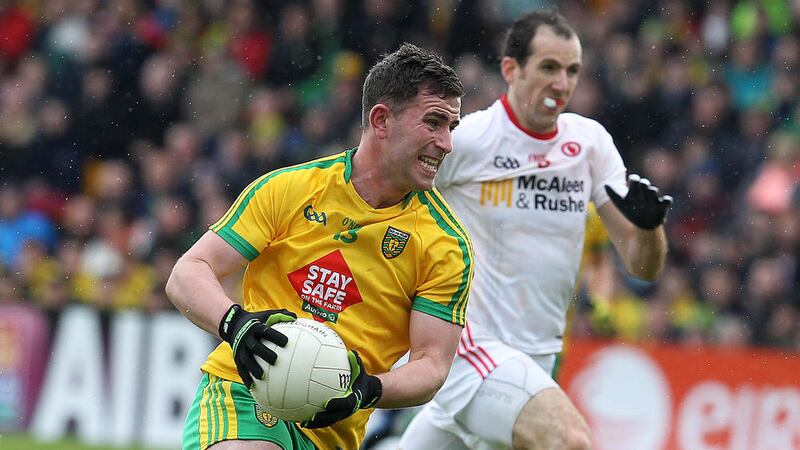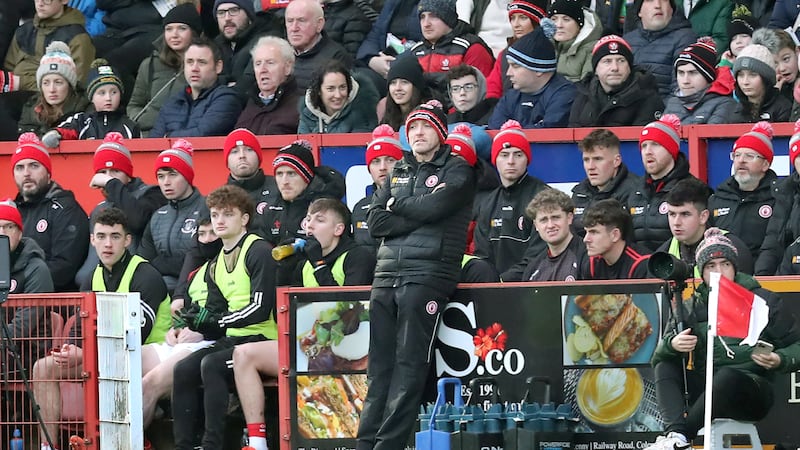GAELIC FOOTBALL has moved on, but the media and GAA officialdom are clinging to a past that has long since ceased to exist.
Not convinced? For evidence, look no further than a match programme. The team line-ups may as well be artefacts from the GAA Museum.
A three-man half-forward line? C’mon! What century is that from? When was the last time anyone saw a county football team play with three half-forwards. The day of Paddy Doherty, James McCartan, and Seán O’Neill, (the greatest half-forward line ever) has gone, and there is no sign of it returning. Even the three-man full-forward line is swiftly becoming a relic of the ancient past.
And, yet, the GAA officials who faithfully produce these programmes, and we in the media, have refused to adapt to the new reality. Unwilling to try something new, we persist with methods which are hopelessly outdated.
The old formation of six defenders, two midfielders, and six forwards needs to be consigned to the dustbin. A new vocabulary is required.
A friend of mine, who works with county teams, has gained an insight into current coaching practices. He has witnessed how the zone defence is set-up, how counter-attacks are coached, and how shooting chances are created.
Last week, he sent me his proposed list of new positions. His glossary more accurately describes the roles performed by the modern county player. I like it a lot. By his reckoning, the typical county football team can be divided into seven key positions. They are:
1. Man-marker
2. Channel blocker
3. Line breaker
4. Midfield anchor
5. Midfield link man
6. Shooter
7. Point of attack
The terms make immediate sense. Take Donegal as an example. In the game against Tyrone, the McGee brothers and Paddy McGrath were the designated man-markers. Ryan McHugh was a channel blocker. Frank McGlynn and Karl Lacey were the line-breakers. Neil Gallagher was the midfield anchor and Christy Toye, Odhrán Mac Niallais, and Martin McElhinney were the midfield link men. Patrick McBrearty was the shooter.
The terms are also adaptable. The nature of the modern game is that most players will be expected to perform a combination of these roles.
Colm McFadden was a midfield link man and a shooter. Michael Murphy’s importance to Donegal is illustrated by the number of roles in which he excels. Over the course of 70 minutes, he will be a line breaker, midfield anchor, point of attack, and shooter.
While the composition of a football team is now a very fluid arrangement, a few players are usually detailed to execute a particular job. When the ball is turned over in defence, an effort is made to transfer possession to the specialist line-breakers. These are the players who have the pace and power to puncture holes in the opposition defence. Tyrone’s line breakers are Mattie Donnelly and Peter Harte. Dublin have Jack McCaffrey. Mayo have Lee Keegan.
Some coaches favour a very prescriptive system. Before the Ulster final in 2013, Monaghan analysed Donegal and realised that, in certain situations, only three players were ever going to shoot. Malachy O’Rourke duly instructed his team not to double team or commit fouls on the ball carrier, who was never going to try a shot.
The clever techniques employed by the better managers have allowed some of the smaller counties to make astounding advances. Both Cavan and Monaghan have tiny populations and a very limited supply of players.
When Malachy O’Rourke became manager, Monaghan were in Division Three. Since then, Monaghan have won the Ulster title and gained promotion to Division One. When Terry Hyland took the reins in Cavan, the senior team was in disarray. Hyland kick-started the revolution in Cavan by guiding the U21s to the first of their four consecutive provincial titles.
Last Sunday, Cavan and Monaghan produced an utterly gripping game of football. Despite blustery conditions, it was a relatively high-scoring encounter which finished 0-16 to 0-15. Both teams deserve immense credit.
It was obvious that a lot of thought and work had gone into Cavan’s game-plan. The decision to play Michael Argue, Ronan Flanagan, and Niall McDermott in a three-man full-forward line was bold and brave.
Cavan also anticipated that Monaghan would keep a sweeper in defence at all times. Their short kick-outs were a resounding success. Cavan’s ability to win possession from nearly all their kick-outs provided the platform for most of their attacks.
Monaghan were too cautious and their hesitancy backfired. Cavan made sure to keep the ball away from Dessie Mone, who was playing as a sweeper (channel blocker). Consequently, Mone was largely ineffectual. Vinny Corey, Monaghan’s best line breaker, rarely ventured forward.
It was only when Monaghan thought they were going to lose the game that they abandoned their ultra-conservative approach. When Mone pushed up the field, and Corey started to attack, Monaghan were transformed. The introduction of Dick Clerkin and Colin Walshe also made a huge difference.
Cavan didn’t lose the game. Monaghan won it by throwing off the shackles and going for the jugular.
Yet, the analysis on The Sunday Game bore little or no relevance to what was witnessed in Kingspan Breffni Park.
In what appeared to be a pre-ordained script, Cavan were slated for being too defensive. Their attacking game-plan was portrayed as being ill-conceived, ineffective, and utterly botched. Meanwhile the impression was given that Monaghan had served up a masterclass of ‘triangles’ and ‘vertical balls’ – whatever they are.
Monaghan were praised. Cavan were damned. But only one point separated the teams. The absurdity of the analysis can be illustrated with one statistic. In the absence of a top class forward like Conor McManus, Cavan actually managed to score more from play than Monaghan.
Cavan didn’t lose the game because of a flawed game-plan. A tally of 0-15 against Monaghan was a fantastic return. The primary reason they lost was because they conceded too many scoreable frees.
Inter-county managers take a lot of flak, and some of it is thoroughly deserved. But Terry Hyland was poorly treated by The Sunday Game. Anyone who tuned into Sunday’s night programme would have quickly reached the conclusion that Cavan hadn’t a clue what they were doing – and that’s unfair.
Given the huge effort made by players and managers, they really do deserve a better service. In the newspapers, we are still dutifully listing teams in archaic 6-2-6 formations. While on the television, analysts are sticking to tired, over-played generalisations that bear absolutely no relevance to what is happening on the pitch.
Is it any wonder managers treat us with such barely concealed disdain?







